Comprehensive Report: Evaluating Research on Leadership Coaching
VerifiedAdded on 2023/06/11
|10
|2588
|143
Report
AI Summary
This report provides a comprehensive evaluation of a research article focusing on leadership coaching. It assesses the literature review, the appropriateness of using mixed methods (both qualitative and quantitative data analysis), justification and description of data collection methods such as focus groups and questionnaires, and the critique of the sampling strategy and respondent selection. The study examines the impact of leadership coaching on self-efficacy, leadership trust, subordinates’ psychological empowerment, and facilitative coach behavior. The report highlights the use of questionnaires and focus groups to gather data, ensuring anonymity to encourage honest feedback from leaders and managers. Ultimately, the analysis delves into the effectiveness and ethical considerations of the research methodologies employed in understanding the impact of leadership coaching within organizations. Desklib offers this assignment solution along with a wide array of study resources for students.
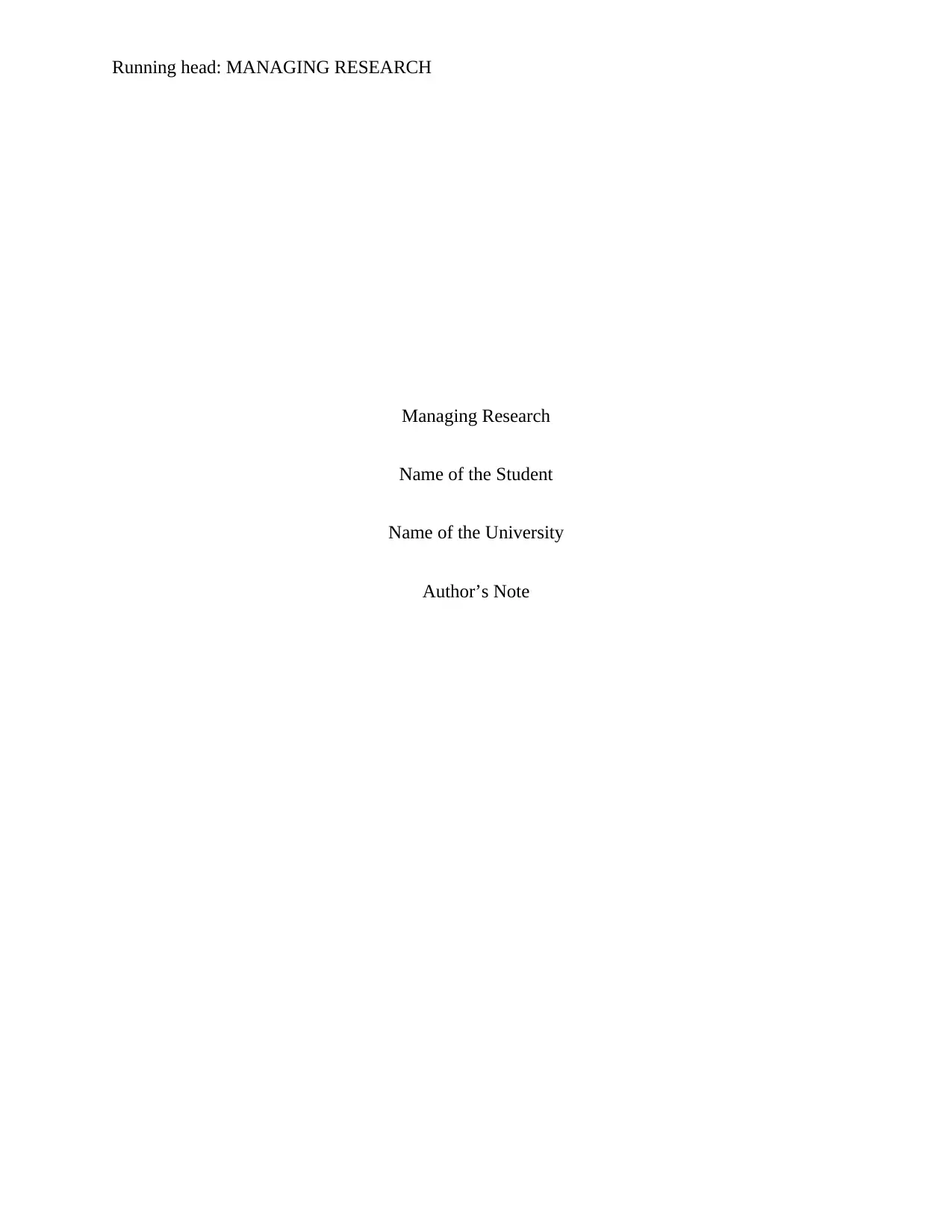
Running head: MANAGING RESEARCH
Managing Research
Name of the Student
Name of the University
Author’s Note
Managing Research
Name of the Student
Name of the University
Author’s Note
Paraphrase This Document
Need a fresh take? Get an instant paraphrase of this document with our AI Paraphraser
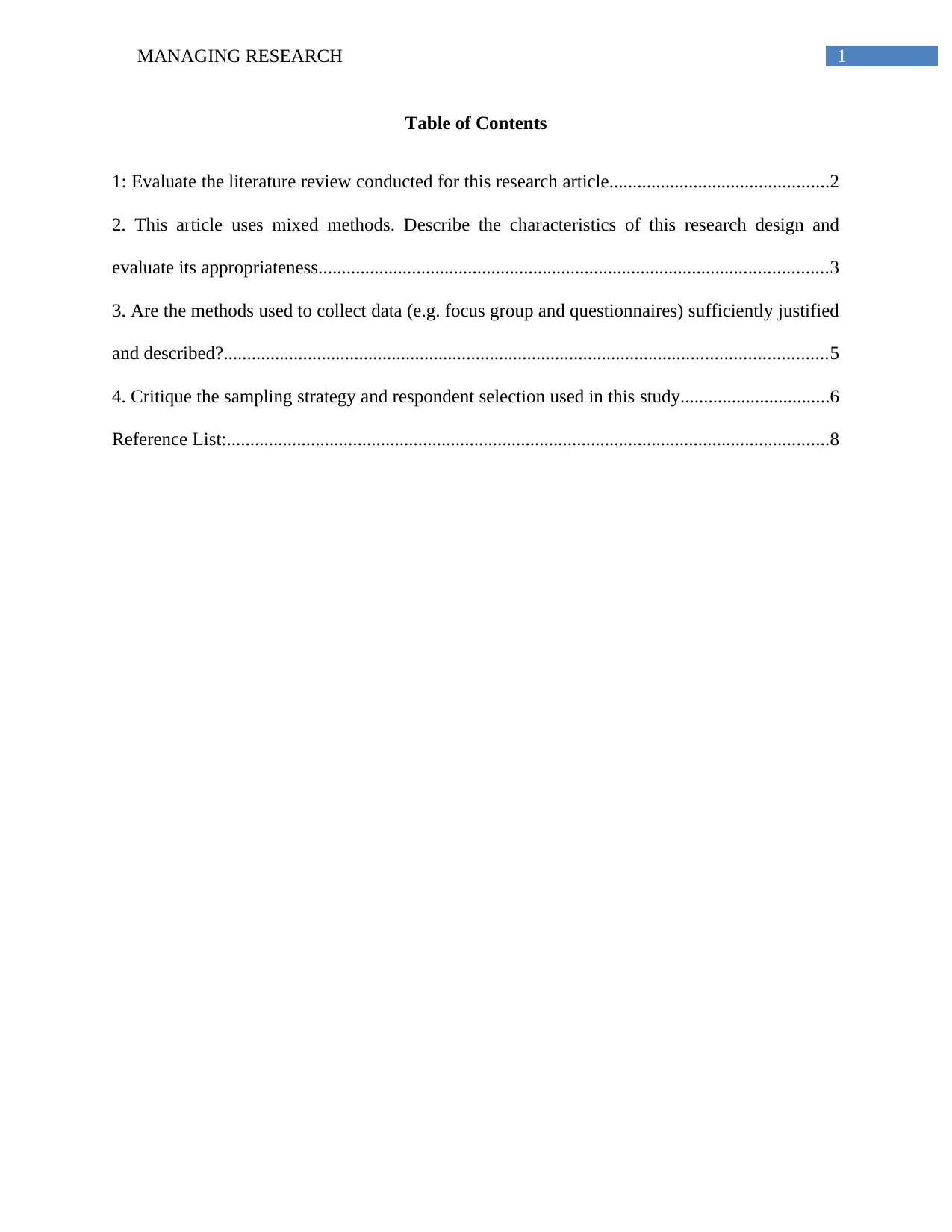
1MANAGING RESEARCH
Table of Contents
1: Evaluate the literature review conducted for this research article...............................................2
2. This article uses mixed methods. Describe the characteristics of this research design and
evaluate its appropriateness.............................................................................................................3
3. Are the methods used to collect data (e.g. focus group and questionnaires) sufficiently justified
and described?.................................................................................................................................5
4. Critique the sampling strategy and respondent selection used in this study................................6
Reference List:.................................................................................................................................8
Table of Contents
1: Evaluate the literature review conducted for this research article...............................................2
2. This article uses mixed methods. Describe the characteristics of this research design and
evaluate its appropriateness.............................................................................................................3
3. Are the methods used to collect data (e.g. focus group and questionnaires) sufficiently justified
and described?.................................................................................................................................5
4. Critique the sampling strategy and respondent selection used in this study................................6
Reference List:.................................................................................................................................8
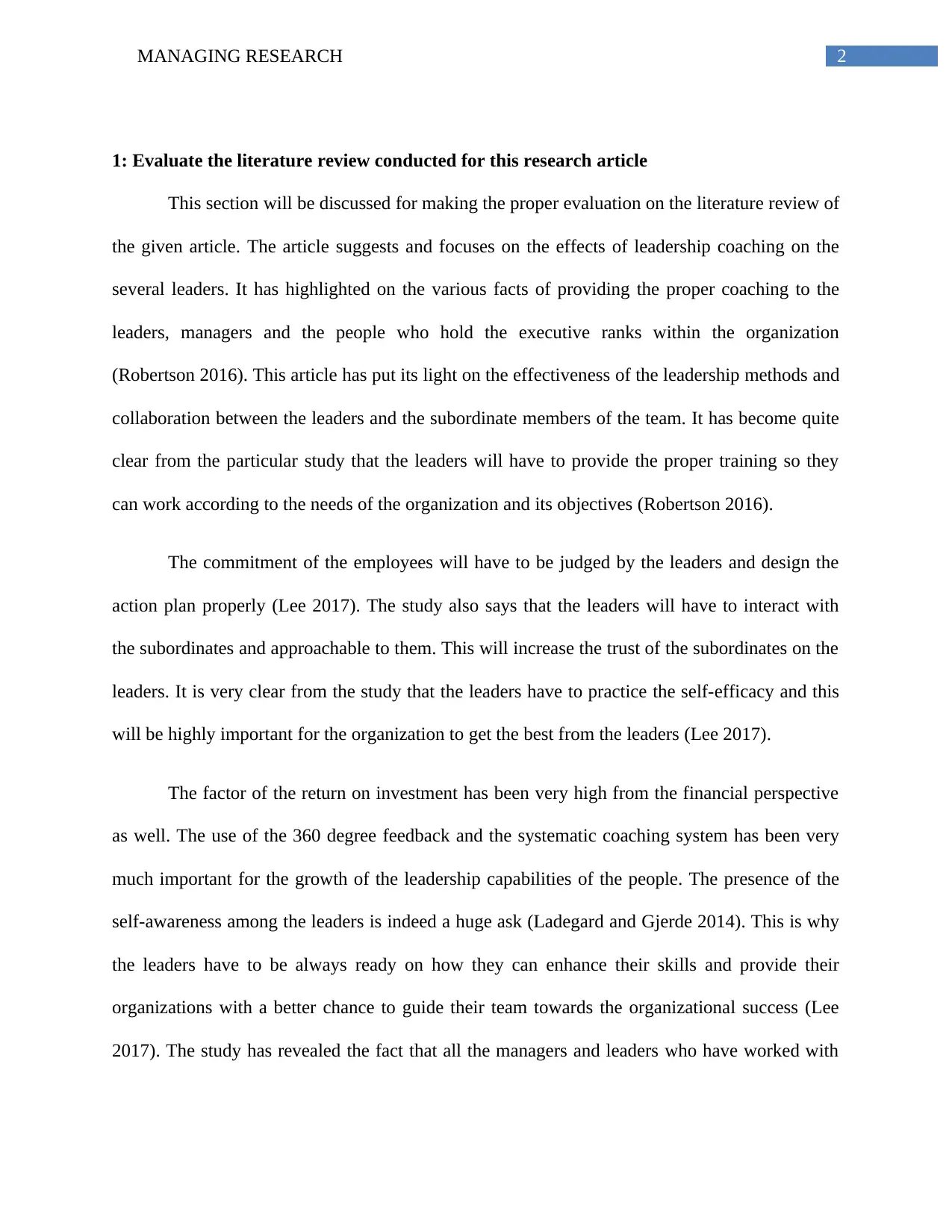
2MANAGING RESEARCH
1: Evaluate the literature review conducted for this research article
This section will be discussed for making the proper evaluation on the literature review of
the given article. The article suggests and focuses on the effects of leadership coaching on the
several leaders. It has highlighted on the various facts of providing the proper coaching to the
leaders, managers and the people who hold the executive ranks within the organization
(Robertson 2016). This article has put its light on the effectiveness of the leadership methods and
collaboration between the leaders and the subordinate members of the team. It has become quite
clear from the particular study that the leaders will have to provide the proper training so they
can work according to the needs of the organization and its objectives (Robertson 2016).
The commitment of the employees will have to be judged by the leaders and design the
action plan properly (Lee 2017). The study also says that the leaders will have to interact with
the subordinates and approachable to them. This will increase the trust of the subordinates on the
leaders. It is very clear from the study that the leaders have to practice the self-efficacy and this
will be highly important for the organization to get the best from the leaders (Lee 2017).
The factor of the return on investment has been very high from the financial perspective
as well. The use of the 360 degree feedback and the systematic coaching system has been very
much important for the growth of the leadership capabilities of the people. The presence of the
self-awareness among the leaders is indeed a huge ask (Ladegard and Gjerde 2014). This is why
the leaders have to be always ready on how they can enhance their skills and provide their
organizations with a better chance to guide their team towards the organizational success (Lee
2017). The study has revealed the fact that all the managers and leaders who have worked with
1: Evaluate the literature review conducted for this research article
This section will be discussed for making the proper evaluation on the literature review of
the given article. The article suggests and focuses on the effects of leadership coaching on the
several leaders. It has highlighted on the various facts of providing the proper coaching to the
leaders, managers and the people who hold the executive ranks within the organization
(Robertson 2016). This article has put its light on the effectiveness of the leadership methods and
collaboration between the leaders and the subordinate members of the team. It has become quite
clear from the particular study that the leaders will have to provide the proper training so they
can work according to the needs of the organization and its objectives (Robertson 2016).
The commitment of the employees will have to be judged by the leaders and design the
action plan properly (Lee 2017). The study also says that the leaders will have to interact with
the subordinates and approachable to them. This will increase the trust of the subordinates on the
leaders. It is very clear from the study that the leaders have to practice the self-efficacy and this
will be highly important for the organization to get the best from the leaders (Lee 2017).
The factor of the return on investment has been very high from the financial perspective
as well. The use of the 360 degree feedback and the systematic coaching system has been very
much important for the growth of the leadership capabilities of the people. The presence of the
self-awareness among the leaders is indeed a huge ask (Ladegard and Gjerde 2014). This is why
the leaders have to be always ready on how they can enhance their skills and provide their
organizations with a better chance to guide their team towards the organizational success (Lee
2017). The study has revealed the fact that all the managers and leaders who have worked with
⊘ This is a preview!⊘
Do you want full access?
Subscribe today to unlock all pages.

Trusted by 1+ million students worldwide
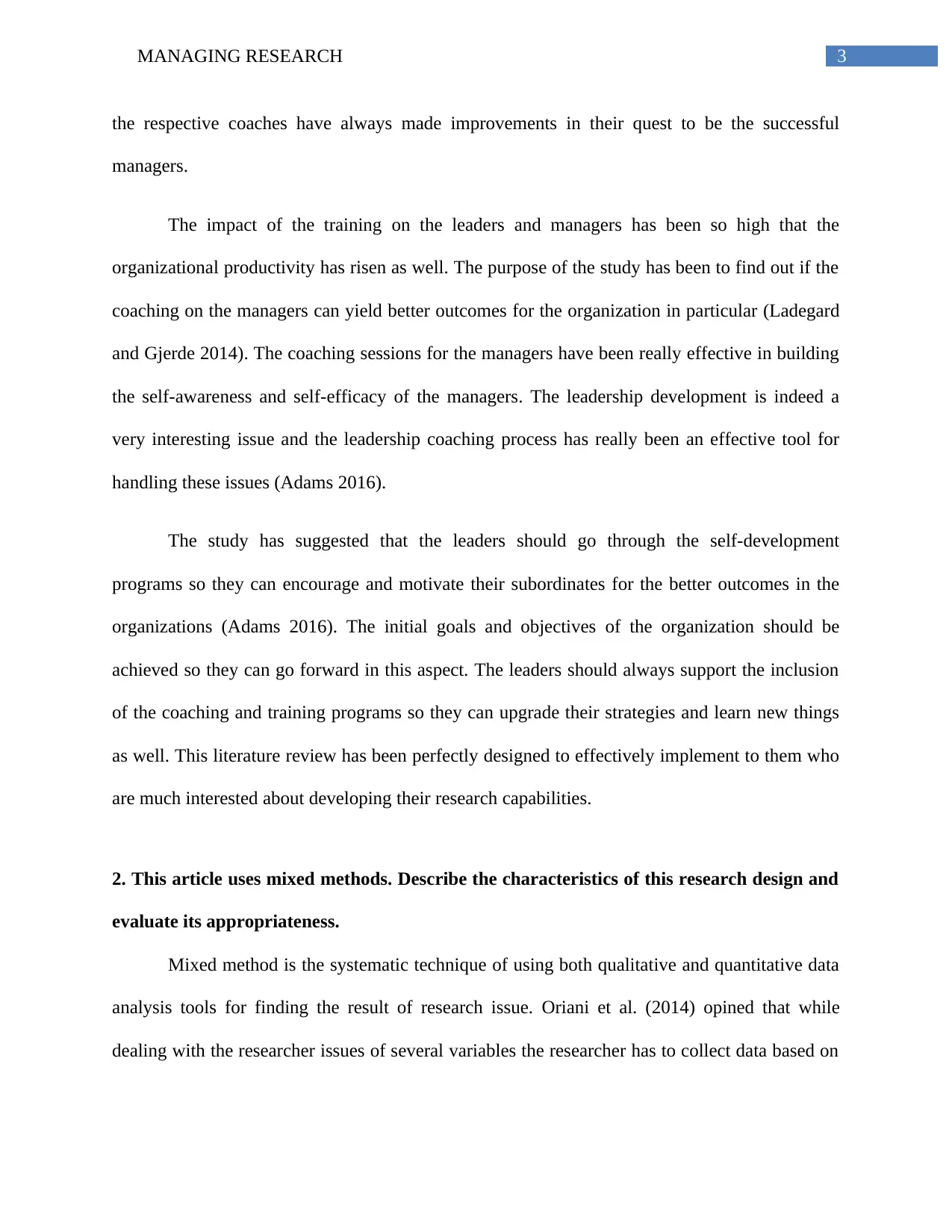
3MANAGING RESEARCH
the respective coaches have always made improvements in their quest to be the successful
managers.
The impact of the training on the leaders and managers has been so high that the
organizational productivity has risen as well. The purpose of the study has been to find out if the
coaching on the managers can yield better outcomes for the organization in particular (Ladegard
and Gjerde 2014). The coaching sessions for the managers have been really effective in building
the self-awareness and self-efficacy of the managers. The leadership development is indeed a
very interesting issue and the leadership coaching process has really been an effective tool for
handling these issues (Adams 2016).
The study has suggested that the leaders should go through the self-development
programs so they can encourage and motivate their subordinates for the better outcomes in the
organizations (Adams 2016). The initial goals and objectives of the organization should be
achieved so they can go forward in this aspect. The leaders should always support the inclusion
of the coaching and training programs so they can upgrade their strategies and learn new things
as well. This literature review has been perfectly designed to effectively implement to them who
are much interested about developing their research capabilities.
2. This article uses mixed methods. Describe the characteristics of this research design and
evaluate its appropriateness.
Mixed method is the systematic technique of using both qualitative and quantitative data
analysis tools for finding the result of research issue. Oriani et al. (2014) opined that while
dealing with the researcher issues of several variables the researcher has to collect data based on
the respective coaches have always made improvements in their quest to be the successful
managers.
The impact of the training on the leaders and managers has been so high that the
organizational productivity has risen as well. The purpose of the study has been to find out if the
coaching on the managers can yield better outcomes for the organization in particular (Ladegard
and Gjerde 2014). The coaching sessions for the managers have been really effective in building
the self-awareness and self-efficacy of the managers. The leadership development is indeed a
very interesting issue and the leadership coaching process has really been an effective tool for
handling these issues (Adams 2016).
The study has suggested that the leaders should go through the self-development
programs so they can encourage and motivate their subordinates for the better outcomes in the
organizations (Adams 2016). The initial goals and objectives of the organization should be
achieved so they can go forward in this aspect. The leaders should always support the inclusion
of the coaching and training programs so they can upgrade their strategies and learn new things
as well. This literature review has been perfectly designed to effectively implement to them who
are much interested about developing their research capabilities.
2. This article uses mixed methods. Describe the characteristics of this research design and
evaluate its appropriateness.
Mixed method is the systematic technique of using both qualitative and quantitative data
analysis tools for finding the result of research issue. Oriani et al. (2014) opined that while
dealing with the researcher issues of several variables the researcher has to collect data based on
Paraphrase This Document
Need a fresh take? Get an instant paraphrase of this document with our AI Paraphraser
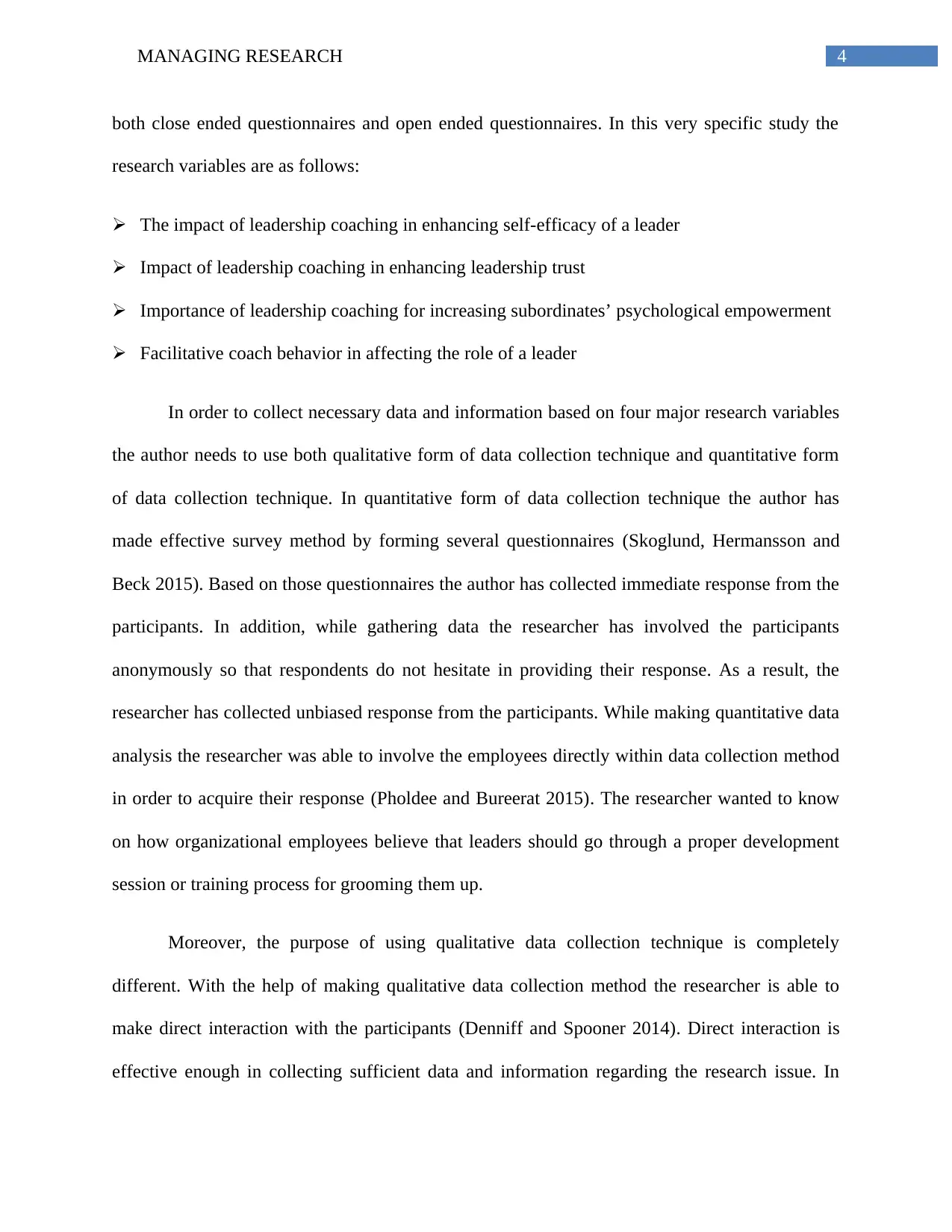
4MANAGING RESEARCH
both close ended questionnaires and open ended questionnaires. In this very specific study the
research variables are as follows:
The impact of leadership coaching in enhancing self-efficacy of a leader
Impact of leadership coaching in enhancing leadership trust
Importance of leadership coaching for increasing subordinates’ psychological empowerment
Facilitative coach behavior in affecting the role of a leader
In order to collect necessary data and information based on four major research variables
the author needs to use both qualitative form of data collection technique and quantitative form
of data collection technique. In quantitative form of data collection technique the author has
made effective survey method by forming several questionnaires (Skoglund, Hermansson and
Beck 2015). Based on those questionnaires the author has collected immediate response from the
participants. In addition, while gathering data the researcher has involved the participants
anonymously so that respondents do not hesitate in providing their response. As a result, the
researcher has collected unbiased response from the participants. While making quantitative data
analysis the researcher was able to involve the employees directly within data collection method
in order to acquire their response (Pholdee and Bureerat 2015). The researcher wanted to know
on how organizational employees believe that leaders should go through a proper development
session or training process for grooming them up.
Moreover, the purpose of using qualitative data collection technique is completely
different. With the help of making qualitative data collection method the researcher is able to
make direct interaction with the participants (Denniff and Spooner 2014). Direct interaction is
effective enough in collecting sufficient data and information regarding the research issue. In
both close ended questionnaires and open ended questionnaires. In this very specific study the
research variables are as follows:
The impact of leadership coaching in enhancing self-efficacy of a leader
Impact of leadership coaching in enhancing leadership trust
Importance of leadership coaching for increasing subordinates’ psychological empowerment
Facilitative coach behavior in affecting the role of a leader
In order to collect necessary data and information based on four major research variables
the author needs to use both qualitative form of data collection technique and quantitative form
of data collection technique. In quantitative form of data collection technique the author has
made effective survey method by forming several questionnaires (Skoglund, Hermansson and
Beck 2015). Based on those questionnaires the author has collected immediate response from the
participants. In addition, while gathering data the researcher has involved the participants
anonymously so that respondents do not hesitate in providing their response. As a result, the
researcher has collected unbiased response from the participants. While making quantitative data
analysis the researcher was able to involve the employees directly within data collection method
in order to acquire their response (Pholdee and Bureerat 2015). The researcher wanted to know
on how organizational employees believe that leaders should go through a proper development
session or training process for grooming them up.
Moreover, the purpose of using qualitative data collection technique is completely
different. With the help of making qualitative data collection method the researcher is able to
make direct interaction with the participants (Denniff and Spooner 2014). Direct interaction is
effective enough in collecting sufficient data and information regarding the research issue. In
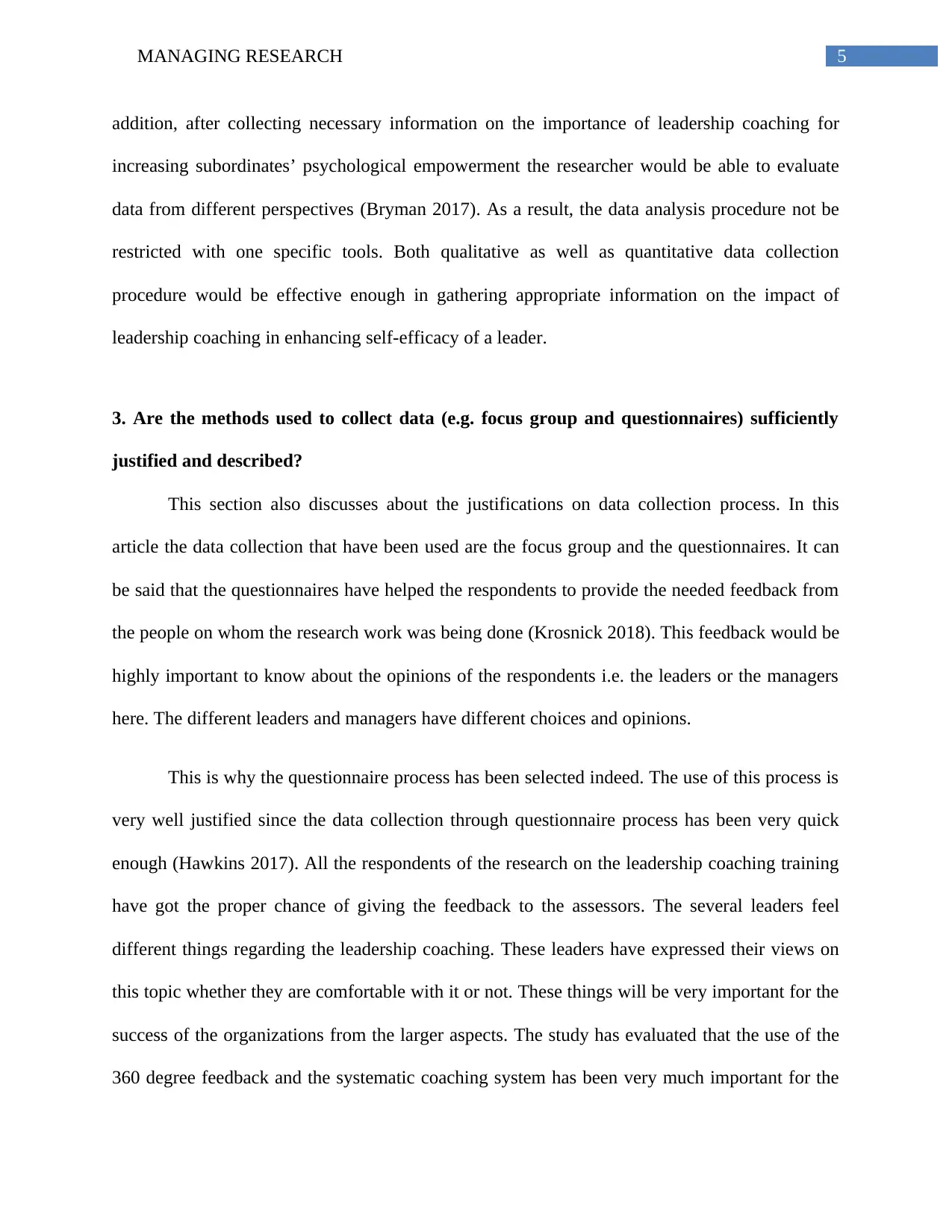
5MANAGING RESEARCH
addition, after collecting necessary information on the importance of leadership coaching for
increasing subordinates’ psychological empowerment the researcher would be able to evaluate
data from different perspectives (Bryman 2017). As a result, the data analysis procedure not be
restricted with one specific tools. Both qualitative as well as quantitative data collection
procedure would be effective enough in gathering appropriate information on the impact of
leadership coaching in enhancing self-efficacy of a leader.
3. Are the methods used to collect data (e.g. focus group and questionnaires) sufficiently
justified and described?
This section also discusses about the justifications on data collection process. In this
article the data collection that have been used are the focus group and the questionnaires. It can
be said that the questionnaires have helped the respondents to provide the needed feedback from
the people on whom the research work was being done (Krosnick 2018). This feedback would be
highly important to know about the opinions of the respondents i.e. the leaders or the managers
here. The different leaders and managers have different choices and opinions.
This is why the questionnaire process has been selected indeed. The use of this process is
very well justified since the data collection through questionnaire process has been very quick
enough (Hawkins 2017). All the respondents of the research on the leadership coaching training
have got the proper chance of giving the feedback to the assessors. The several leaders feel
different things regarding the leadership coaching. These leaders have expressed their views on
this topic whether they are comfortable with it or not. These things will be very important for the
success of the organizations from the larger aspects. The study has evaluated that the use of the
360 degree feedback and the systematic coaching system has been very much important for the
addition, after collecting necessary information on the importance of leadership coaching for
increasing subordinates’ psychological empowerment the researcher would be able to evaluate
data from different perspectives (Bryman 2017). As a result, the data analysis procedure not be
restricted with one specific tools. Both qualitative as well as quantitative data collection
procedure would be effective enough in gathering appropriate information on the impact of
leadership coaching in enhancing self-efficacy of a leader.
3. Are the methods used to collect data (e.g. focus group and questionnaires) sufficiently
justified and described?
This section also discusses about the justifications on data collection process. In this
article the data collection that have been used are the focus group and the questionnaires. It can
be said that the questionnaires have helped the respondents to provide the needed feedback from
the people on whom the research work was being done (Krosnick 2018). This feedback would be
highly important to know about the opinions of the respondents i.e. the leaders or the managers
here. The different leaders and managers have different choices and opinions.
This is why the questionnaire process has been selected indeed. The use of this process is
very well justified since the data collection through questionnaire process has been very quick
enough (Hawkins 2017). All the respondents of the research on the leadership coaching training
have got the proper chance of giving the feedback to the assessors. The several leaders feel
different things regarding the leadership coaching. These leaders have expressed their views on
this topic whether they are comfortable with it or not. These things will be very important for the
success of the organizations from the larger aspects. The study has evaluated that the use of the
360 degree feedback and the systematic coaching system has been very much important for the
⊘ This is a preview!⊘
Do you want full access?
Subscribe today to unlock all pages.

Trusted by 1+ million students worldwide
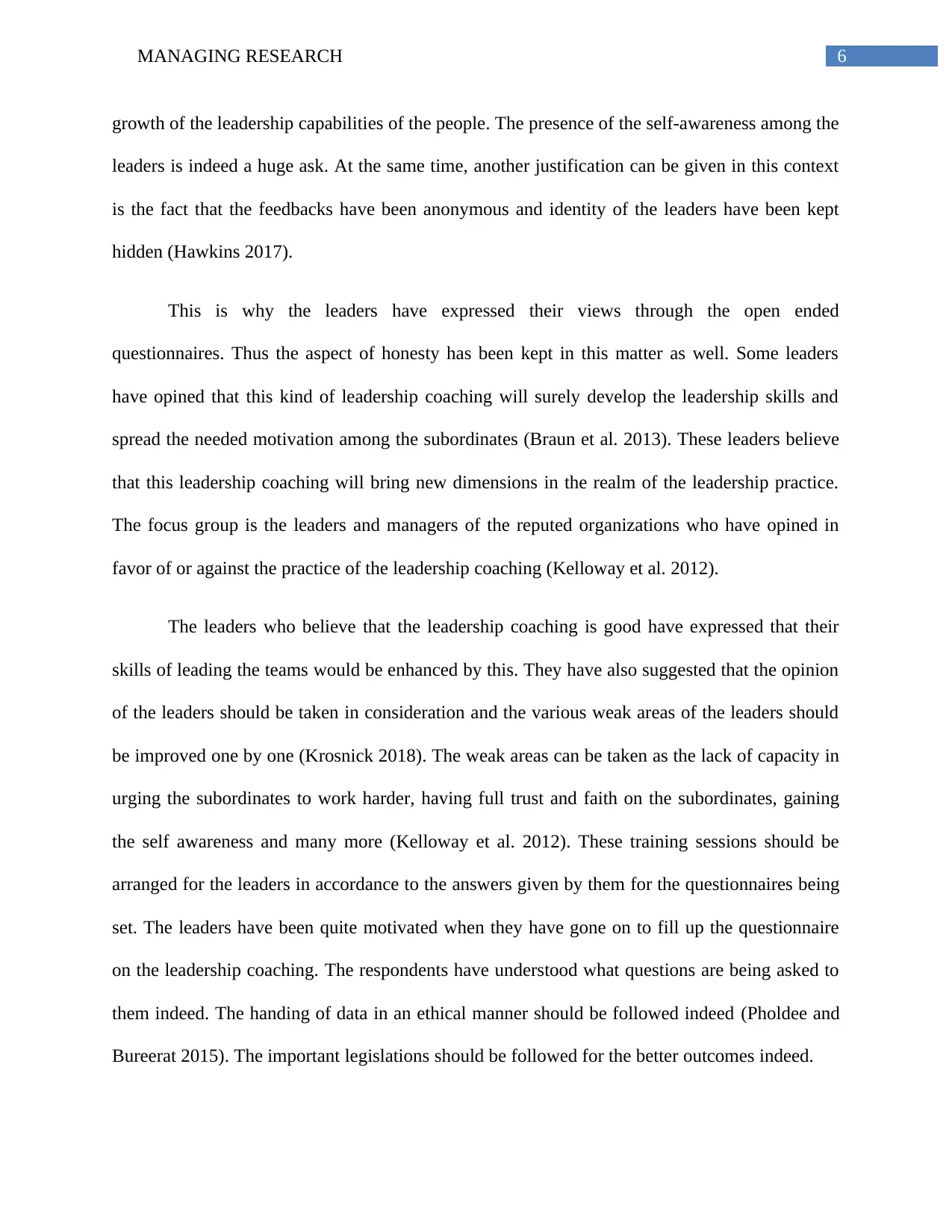
6MANAGING RESEARCH
growth of the leadership capabilities of the people. The presence of the self-awareness among the
leaders is indeed a huge ask. At the same time, another justification can be given in this context
is the fact that the feedbacks have been anonymous and identity of the leaders have been kept
hidden (Hawkins 2017).
This is why the leaders have expressed their views through the open ended
questionnaires. Thus the aspect of honesty has been kept in this matter as well. Some leaders
have opined that this kind of leadership coaching will surely develop the leadership skills and
spread the needed motivation among the subordinates (Braun et al. 2013). These leaders believe
that this leadership coaching will bring new dimensions in the realm of the leadership practice.
The focus group is the leaders and managers of the reputed organizations who have opined in
favor of or against the practice of the leadership coaching (Kelloway et al. 2012).
The leaders who believe that the leadership coaching is good have expressed that their
skills of leading the teams would be enhanced by this. They have also suggested that the opinion
of the leaders should be taken in consideration and the various weak areas of the leaders should
be improved one by one (Krosnick 2018). The weak areas can be taken as the lack of capacity in
urging the subordinates to work harder, having full trust and faith on the subordinates, gaining
the self awareness and many more (Kelloway et al. 2012). These training sessions should be
arranged for the leaders in accordance to the answers given by them for the questionnaires being
set. The leaders have been quite motivated when they have gone on to fill up the questionnaire
on the leadership coaching. The respondents have understood what questions are being asked to
them indeed. The handing of data in an ethical manner should be followed indeed (Pholdee and
Bureerat 2015). The important legislations should be followed for the better outcomes indeed.
growth of the leadership capabilities of the people. The presence of the self-awareness among the
leaders is indeed a huge ask. At the same time, another justification can be given in this context
is the fact that the feedbacks have been anonymous and identity of the leaders have been kept
hidden (Hawkins 2017).
This is why the leaders have expressed their views through the open ended
questionnaires. Thus the aspect of honesty has been kept in this matter as well. Some leaders
have opined that this kind of leadership coaching will surely develop the leadership skills and
spread the needed motivation among the subordinates (Braun et al. 2013). These leaders believe
that this leadership coaching will bring new dimensions in the realm of the leadership practice.
The focus group is the leaders and managers of the reputed organizations who have opined in
favor of or against the practice of the leadership coaching (Kelloway et al. 2012).
The leaders who believe that the leadership coaching is good have expressed that their
skills of leading the teams would be enhanced by this. They have also suggested that the opinion
of the leaders should be taken in consideration and the various weak areas of the leaders should
be improved one by one (Krosnick 2018). The weak areas can be taken as the lack of capacity in
urging the subordinates to work harder, having full trust and faith on the subordinates, gaining
the self awareness and many more (Kelloway et al. 2012). These training sessions should be
arranged for the leaders in accordance to the answers given by them for the questionnaires being
set. The leaders have been quite motivated when they have gone on to fill up the questionnaire
on the leadership coaching. The respondents have understood what questions are being asked to
them indeed. The handing of data in an ethical manner should be followed indeed (Pholdee and
Bureerat 2015). The important legislations should be followed for the better outcomes indeed.
Paraphrase This Document
Need a fresh take? Get an instant paraphrase of this document with our AI Paraphraser
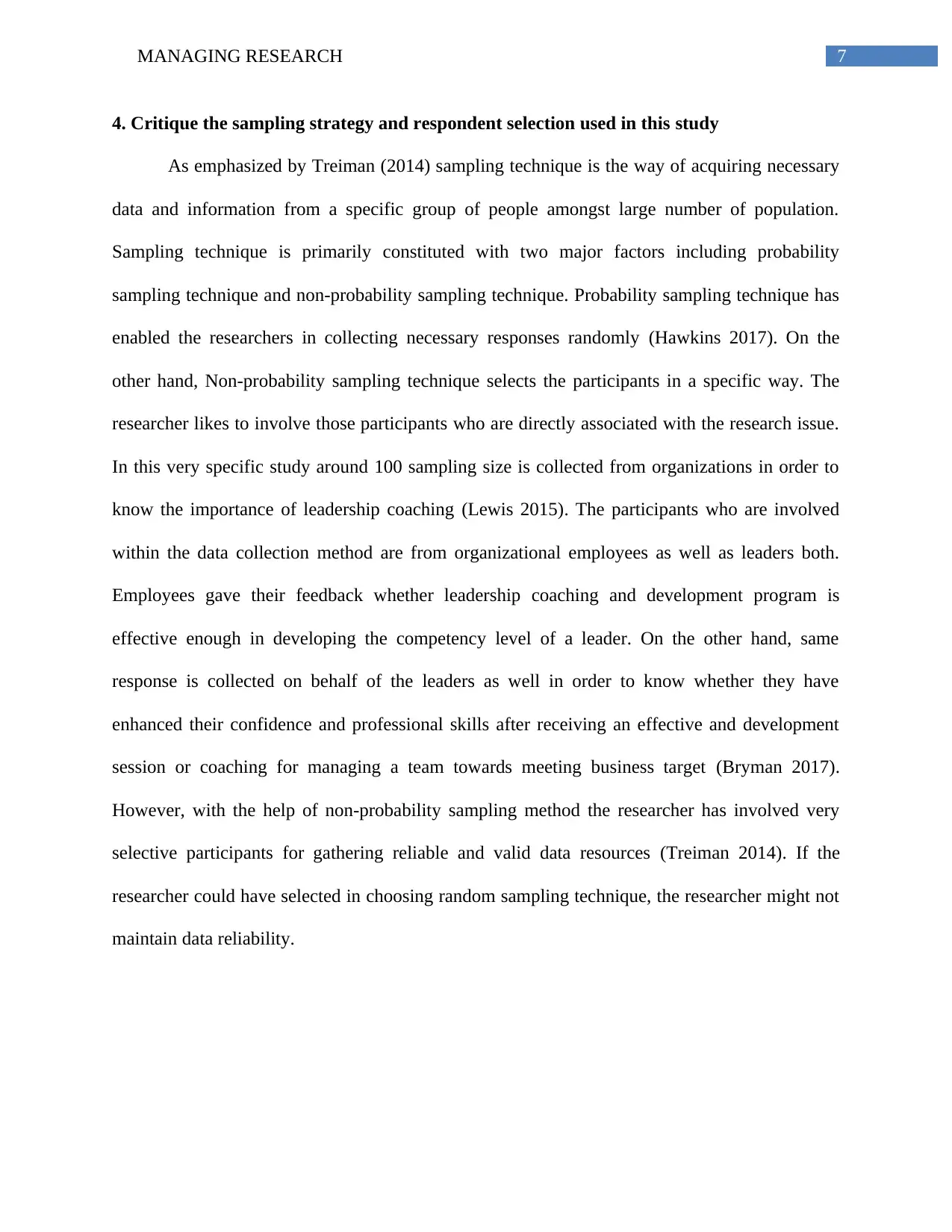
7MANAGING RESEARCH
4. Critique the sampling strategy and respondent selection used in this study
As emphasized by Treiman (2014) sampling technique is the way of acquiring necessary
data and information from a specific group of people amongst large number of population.
Sampling technique is primarily constituted with two major factors including probability
sampling technique and non-probability sampling technique. Probability sampling technique has
enabled the researchers in collecting necessary responses randomly (Hawkins 2017). On the
other hand, Non-probability sampling technique selects the participants in a specific way. The
researcher likes to involve those participants who are directly associated with the research issue.
In this very specific study around 100 sampling size is collected from organizations in order to
know the importance of leadership coaching (Lewis 2015). The participants who are involved
within the data collection method are from organizational employees as well as leaders both.
Employees gave their feedback whether leadership coaching and development program is
effective enough in developing the competency level of a leader. On the other hand, same
response is collected on behalf of the leaders as well in order to know whether they have
enhanced their confidence and professional skills after receiving an effective and development
session or coaching for managing a team towards meeting business target (Bryman 2017).
However, with the help of non-probability sampling method the researcher has involved very
selective participants for gathering reliable and valid data resources (Treiman 2014). If the
researcher could have selected in choosing random sampling technique, the researcher might not
maintain data reliability.
4. Critique the sampling strategy and respondent selection used in this study
As emphasized by Treiman (2014) sampling technique is the way of acquiring necessary
data and information from a specific group of people amongst large number of population.
Sampling technique is primarily constituted with two major factors including probability
sampling technique and non-probability sampling technique. Probability sampling technique has
enabled the researchers in collecting necessary responses randomly (Hawkins 2017). On the
other hand, Non-probability sampling technique selects the participants in a specific way. The
researcher likes to involve those participants who are directly associated with the research issue.
In this very specific study around 100 sampling size is collected from organizations in order to
know the importance of leadership coaching (Lewis 2015). The participants who are involved
within the data collection method are from organizational employees as well as leaders both.
Employees gave their feedback whether leadership coaching and development program is
effective enough in developing the competency level of a leader. On the other hand, same
response is collected on behalf of the leaders as well in order to know whether they have
enhanced their confidence and professional skills after receiving an effective and development
session or coaching for managing a team towards meeting business target (Bryman 2017).
However, with the help of non-probability sampling method the researcher has involved very
selective participants for gathering reliable and valid data resources (Treiman 2014). If the
researcher could have selected in choosing random sampling technique, the researcher might not
maintain data reliability.
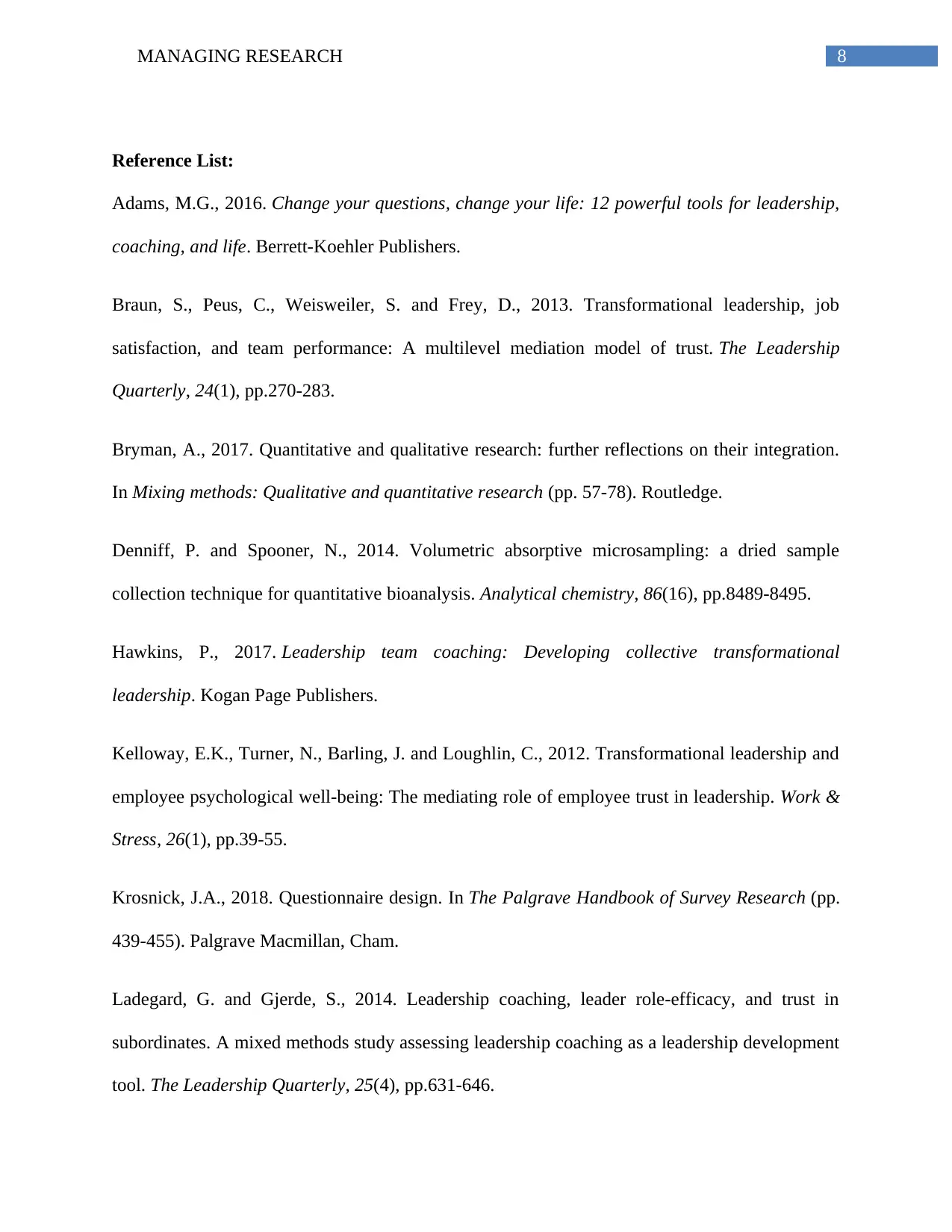
8MANAGING RESEARCH
Reference List:
Adams, M.G., 2016. Change your questions, change your life: 12 powerful tools for leadership,
coaching, and life. Berrett-Koehler Publishers.
Braun, S., Peus, C., Weisweiler, S. and Frey, D., 2013. Transformational leadership, job
satisfaction, and team performance: A multilevel mediation model of trust. The Leadership
Quarterly, 24(1), pp.270-283.
Bryman, A., 2017. Quantitative and qualitative research: further reflections on their integration.
In Mixing methods: Qualitative and quantitative research (pp. 57-78). Routledge.
Denniff, P. and Spooner, N., 2014. Volumetric absorptive microsampling: a dried sample
collection technique for quantitative bioanalysis. Analytical chemistry, 86(16), pp.8489-8495.
Hawkins, P., 2017. Leadership team coaching: Developing collective transformational
leadership. Kogan Page Publishers.
Kelloway, E.K., Turner, N., Barling, J. and Loughlin, C., 2012. Transformational leadership and
employee psychological well-being: The mediating role of employee trust in leadership. Work &
Stress, 26(1), pp.39-55.
Krosnick, J.A., 2018. Questionnaire design. In The Palgrave Handbook of Survey Research (pp.
439-455). Palgrave Macmillan, Cham.
Ladegard, G. and Gjerde, S., 2014. Leadership coaching, leader role-efficacy, and trust in
subordinates. A mixed methods study assessing leadership coaching as a leadership development
tool. The Leadership Quarterly, 25(4), pp.631-646.
Reference List:
Adams, M.G., 2016. Change your questions, change your life: 12 powerful tools for leadership,
coaching, and life. Berrett-Koehler Publishers.
Braun, S., Peus, C., Weisweiler, S. and Frey, D., 2013. Transformational leadership, job
satisfaction, and team performance: A multilevel mediation model of trust. The Leadership
Quarterly, 24(1), pp.270-283.
Bryman, A., 2017. Quantitative and qualitative research: further reflections on their integration.
In Mixing methods: Qualitative and quantitative research (pp. 57-78). Routledge.
Denniff, P. and Spooner, N., 2014. Volumetric absorptive microsampling: a dried sample
collection technique for quantitative bioanalysis. Analytical chemistry, 86(16), pp.8489-8495.
Hawkins, P., 2017. Leadership team coaching: Developing collective transformational
leadership. Kogan Page Publishers.
Kelloway, E.K., Turner, N., Barling, J. and Loughlin, C., 2012. Transformational leadership and
employee psychological well-being: The mediating role of employee trust in leadership. Work &
Stress, 26(1), pp.39-55.
Krosnick, J.A., 2018. Questionnaire design. In The Palgrave Handbook of Survey Research (pp.
439-455). Palgrave Macmillan, Cham.
Ladegard, G. and Gjerde, S., 2014. Leadership coaching, leader role-efficacy, and trust in
subordinates. A mixed methods study assessing leadership coaching as a leadership development
tool. The Leadership Quarterly, 25(4), pp.631-646.
⊘ This is a preview!⊘
Do you want full access?
Subscribe today to unlock all pages.

Trusted by 1+ million students worldwide
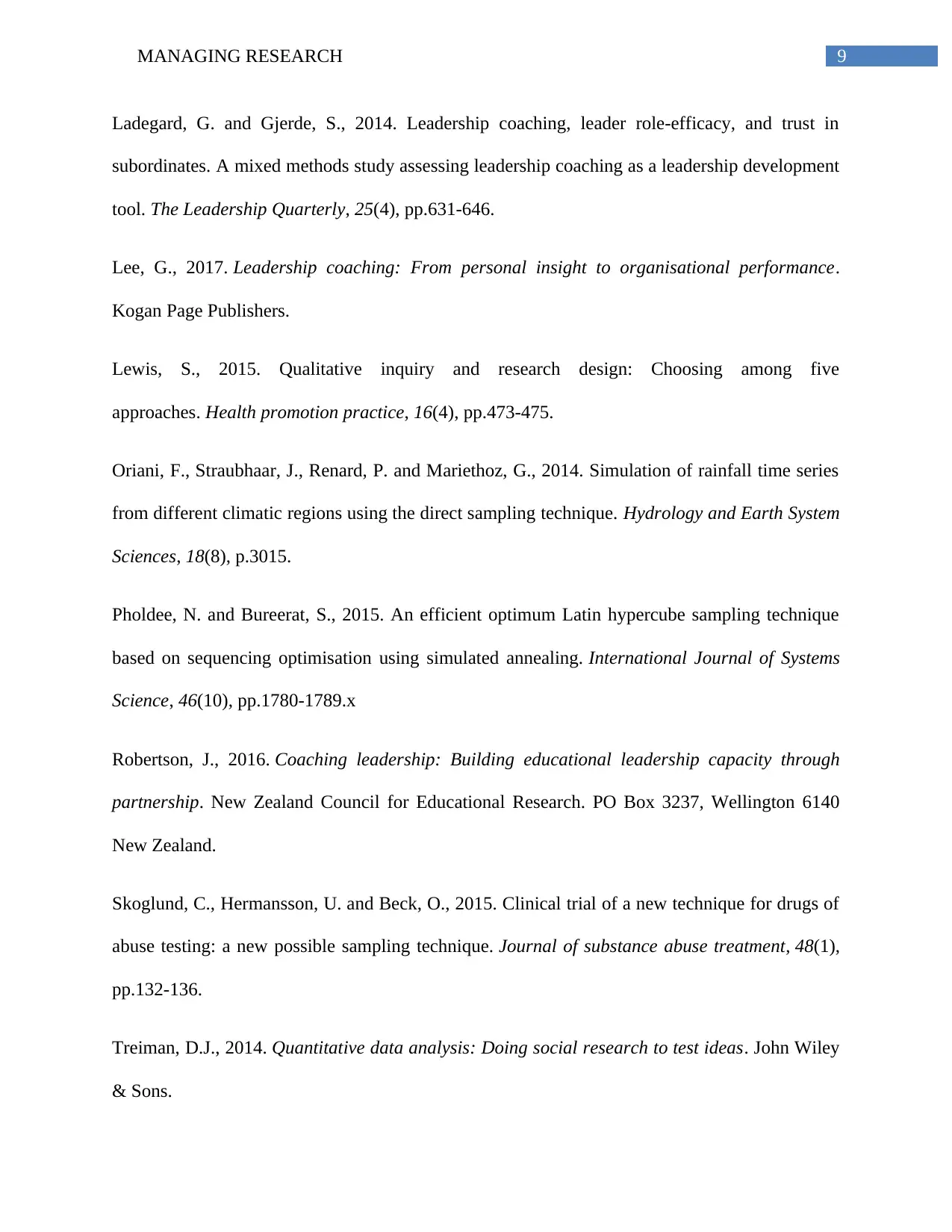
9MANAGING RESEARCH
Ladegard, G. and Gjerde, S., 2014. Leadership coaching, leader role-efficacy, and trust in
subordinates. A mixed methods study assessing leadership coaching as a leadership development
tool. The Leadership Quarterly, 25(4), pp.631-646.
Lee, G., 2017. Leadership coaching: From personal insight to organisational performance.
Kogan Page Publishers.
Lewis, S., 2015. Qualitative inquiry and research design: Choosing among five
approaches. Health promotion practice, 16(4), pp.473-475.
Oriani, F., Straubhaar, J., Renard, P. and Mariethoz, G., 2014. Simulation of rainfall time series
from different climatic regions using the direct sampling technique. Hydrology and Earth System
Sciences, 18(8), p.3015.
Pholdee, N. and Bureerat, S., 2015. An efficient optimum Latin hypercube sampling technique
based on sequencing optimisation using simulated annealing. International Journal of Systems
Science, 46(10), pp.1780-1789.x
Robertson, J., 2016. Coaching leadership: Building educational leadership capacity through
partnership. New Zealand Council for Educational Research. PO Box 3237, Wellington 6140
New Zealand.
Skoglund, C., Hermansson, U. and Beck, O., 2015. Clinical trial of a new technique for drugs of
abuse testing: a new possible sampling technique. Journal of substance abuse treatment, 48(1),
pp.132-136.
Treiman, D.J., 2014. Quantitative data analysis: Doing social research to test ideas. John Wiley
& Sons.
Ladegard, G. and Gjerde, S., 2014. Leadership coaching, leader role-efficacy, and trust in
subordinates. A mixed methods study assessing leadership coaching as a leadership development
tool. The Leadership Quarterly, 25(4), pp.631-646.
Lee, G., 2017. Leadership coaching: From personal insight to organisational performance.
Kogan Page Publishers.
Lewis, S., 2015. Qualitative inquiry and research design: Choosing among five
approaches. Health promotion practice, 16(4), pp.473-475.
Oriani, F., Straubhaar, J., Renard, P. and Mariethoz, G., 2014. Simulation of rainfall time series
from different climatic regions using the direct sampling technique. Hydrology and Earth System
Sciences, 18(8), p.3015.
Pholdee, N. and Bureerat, S., 2015. An efficient optimum Latin hypercube sampling technique
based on sequencing optimisation using simulated annealing. International Journal of Systems
Science, 46(10), pp.1780-1789.x
Robertson, J., 2016. Coaching leadership: Building educational leadership capacity through
partnership. New Zealand Council for Educational Research. PO Box 3237, Wellington 6140
New Zealand.
Skoglund, C., Hermansson, U. and Beck, O., 2015. Clinical trial of a new technique for drugs of
abuse testing: a new possible sampling technique. Journal of substance abuse treatment, 48(1),
pp.132-136.
Treiman, D.J., 2014. Quantitative data analysis: Doing social research to test ideas. John Wiley
& Sons.
1 out of 10
Related Documents
Your All-in-One AI-Powered Toolkit for Academic Success.
+13062052269
info@desklib.com
Available 24*7 on WhatsApp / Email
![[object Object]](/_next/static/media/star-bottom.7253800d.svg)
Unlock your academic potential
Copyright © 2020–2025 A2Z Services. All Rights Reserved. Developed and managed by ZUCOL.




